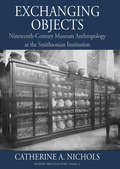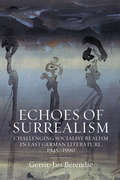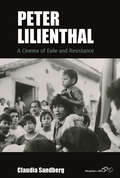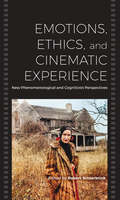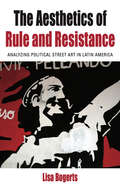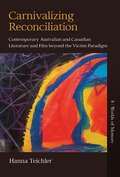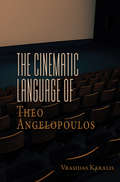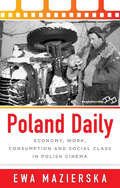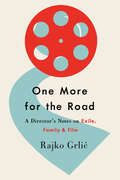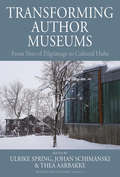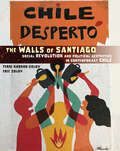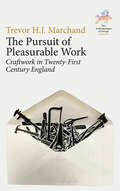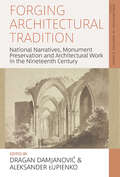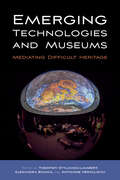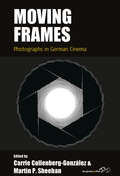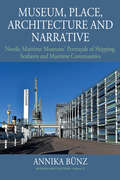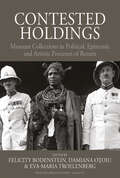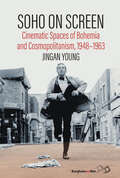- Table View
- List View
Exchanging Objects: Nineteenth-Century Museum Anthropology at the Smithsonian Institution (Museums and Collections #12)
by Catherine A. NicholsAs an historical account of the exchange of “duplicate specimens” between anthropologists at the Smithsonian Institution and museums, collectors, and schools around the world in the late nineteenth century, this book reveals connections between both well-known museums and little-known local institutions, created through the exchange of museum objects. It explores how anthropologists categorized some objects in their collections as “duplicate specimens,” making them potential candidates for exchange. This historical form of what museum professionals would now call deaccessioning considers the intellectual and technical requirement of classifying objects in museums, and suggests that a deeper understanding of past museum practice can inform mission-driven contemporary museum work.
Echoes of Surrealism: Challenging Socialist Realism in East German Literature, 1945–1990
by Gerrit-Jan BerendseFor many artists and intellectuals in East Germany, daily life had an undeniably surreal aspect, from the numbing repetition of Communist Party jargon to the fear and paranoia engendered by the Stasi. Echoes of Surrealism surveys the ways in which a sense of the surreal infused literature and art across the lifespan of the GDR, focusing on individual authors, visual artists, directors, musicians, and other figures who have employed surrealist techniques in their work. It provides a new framework for understanding East German culture, exploring aesthetic practices that offered an alternative to rigid government policies and questioned and confronted the status quo.
Peter Lilienthal: A Cinema of Exile and Resistance (Film Europa #25)
by Claudia SandbergBest known for his 1979 film David, Peter Lilienthal was an unusual figure within postwar filmmaking circles. A child refugee from Nazi Germany who grew up in Uruguay, he was uniquely situated at the crossroads of German, Jewish, and Latin American cultures: while his work emerged from West German auteur filmmaking, his films bore the unmistakable imprints of Jewish thought and the militant character of New Latin American cinema. Peter Lilienthal is the first comprehensive study of Lilienthal’s life and career, highlighting the distinctively cross-cultural and transnational dimensions of his oeuvre, and exploring his role as an early exemplar of a more vibrant, inclusive European film culture.
Emotions, Ethics, and Cinematic Experience: New Phenomenological and Cognitivist Perspectives
by Robert SinnerbrinkSince the early 1990s, phenomenology and cognitivism have become two of the most influential approaches to film theory. Yet far from being at odds with each other, both approaches offer important insights on our subjective experience of cinema. Emotions, Ethics, and Cinematic Experience explores how these two approaches might work together to create a philosophy of film that is both descriptively rich and theoretically productive by addressing the key relationship between cinematic experience, emotions, and ethics.
The Aesthetics of Rule and Resistance: Analyzing Political Street Art in Latin America (Protest, Culture & Society #29)
by Lisa BogertsEffective visual communication has become an essential strategy for grassroots political activists, who use images to publicly express resistance and make their claims visible in the struggle for political power. However, this “aesthetics of resistance” is also employed by political and economic elites for their own purposes, making it increasingly difficult to distinguish from the “aesthetics of rule.” Through illuminating case studies of street art in Buenos Aires, Bogotá, Caracas, and Mexico City, The Aesthetics of Rule and Resistance explores the visual strategies of persuasion and meaning-making employed by both rulers and resisters to foster self-legitimization, identification, and mobilization.
Carnivalizing Reconciliation: Contemporary Australian and Canadian Literature and Film beyond the Victim Paradigm (Worlds of Memory #8)
by Hanna TeichlerCriminal justice inquiries may be the most historically dramatic means for coming to terms with traumatic legacies, but it is in the more subtle social and cultural processes of “memory work” that most individuals encounter historical reconciliation in practice. This book analyzes, within the realms of national literature and film, recent Australian and Canadian attempts to reconcile with Indigenous populations in the wake of forced child removal. As Hanna Teichler demonstrates, their systematic emphasis on the subjectivity of the victim is “carnivalesque,” temporarily overturning discursive hierarchies. Such fictions of reconciliation venture beyond simplistic narratives and identities defined by victimization, offering new opportunities for confronting painful histories.
The Cinematic Language of Theo Angelopoulos
by Vrasidas KaralisBeginning with his first film Reconstruction, released in 1970, Theo Angelopoulos’s notoriously complex cinematic language has long explored Greece’s contemporary history and questioned European culture and society. The Cinematic Language of Theo Angelopoulos offers a detailed study and critical discussion of the acclaimed filmmaker’s cinematic aesthetics as they developed over his career, exploring different styles through which Greek and European history, identity, and loss have been visually articulated throughout his oeuvre, as well as his impact on both European and global cinema.
Poland Daily: Economy, Work, Consumption and Social Class in Polish Cinema
by Ewa MazierskaLike many Eastern European countries, Poland has seen a succession of divergent economic and political regimes over the last century, from prewar “embedded liberalism,” through the state socialism of the Soviet era, to the present neoliberal moment. Its cinema has been inflected by these changing historical circumstances, both mirroring and resisting them. This volume is the first to analyze the entirety of the nation’s film history—from the reemergence of an independent Poland in 1918 to the present day—through the lenses of political economy and social class, showing how Polish cinema documented ordinary life while bearing the hallmarks of specific ideologies.
One More for the Road: A Director’s Notes on Exile, Family, and Film
by Rajko GrlićOne More for the Road recounts the life and career of Croatian filmmaker Rajko Grlić in the form of a lexicon of film terms, tying cinematic terms to anecdotes spanning Grlić’s life, from his post-Nazi-era childhood in Yugoslavia to his college years during the 1968 invasion of Prague, the Yugoslav dissolution wars, and his subsequent exile in the United States. With a scholarly introduction by Aida Vidan, these personal stories combine to provide insight into the socialist film industries, contextualizing south Slavic film while also highlighting its contacts with Western filmmakers and the film industry.
One More for the Road: A Director’s Notes on Exile, Family, and Film
by Rajko GrlićOne More for the Road recounts the life and career of Croatian filmmaker Rajko Grlić in the form of a lexicon of film terms, tying cinematic terms to anecdotes spanning Grlić’s life, from his post-Nazi-era childhood in Yugoslavia to his college years during the 1968 invasion of Prague, the Yugoslav dissolution wars, and his subsequent exile in the United States. With a scholarly introduction by Aida Vidan, these personal stories combine to provide insight into the socialist film industries, contextualizing south Slavic film while also highlighting its contacts with Western filmmakers and the film industry.
Transforming Author Museums: From Sites of Pilgrimage to Cultural Hubs (Museums and Collections #13)
by Ulrike Spring Johan Schimanski Thea AarbakkeLiterary museums today must respond to new challenges; the traditional image of the author’s home museum as a sacred place of literary pilgrimage centered around a national hero has been questioned, and literary museums have begun to develop new strategies centered not only on biography, but also literary texts, imagined spaces, different readers, historical contexts, architectural concepts, and artistic interventions. As this volume shows, the changing of spaces asks how literary museums create new ways of interlinking real and literary spaces, texts, objects, readers, and tourists.
Transforming Author Museums: From Sites of Pilgrimage to Cultural Hubs (Museums and Collections #13)
by Ulrike Spring, Johan Schimanski Thea AarbakkeLiterary museums today must respond to new challenges; the traditional image of the author’s home museum as a sacred place of literary pilgrimage centered around a national hero has been questioned, and literary museums have begun to develop new strategies centered not only on biography, but also literary texts, imagined spaces, different readers, historical contexts, architectural concepts, and artistic interventions. As this volume shows, the changing of spaces asks how literary museums create new ways of interlinking real and literary spaces, texts, objects, readers, and tourists.
The Walls of Santiago: Social Revolution and Political Aesthetics in Contemporary Chile (Protest, Culture & Society #30)
by Terri Gordon-Zolov Eric ZolovA photo-illustrated record of Chilean protest art, along with reflections on artistic antecedents, global protest movements, and the long shadow cast by Chile’s authoritarian past. “This is an excellent and unique contribution to our understanding of protest art. It is the first substantive treatment in English of an important social movement and a significant contribution to the political impact of the COVID-19 pandemic.”—T.V. Reed, Washington State University From October 2019 until the COVID-19 lockdown in March 2020, Chile was convulsed by protests and political upheaval, as what began as civil disobedience transformed into a vast resistance movement. Throughout, the most striking aspects of the protests were the murals, graffiti, and other political graphics that became ubiquitous in Chilean cities. Authors Terri Gordon-Zolov and Eric Zolov were in Santiago to witness and document the protests from their very beginning. The book is beautifully illustrated with over 150 photographs taken throughout the protests. Additional photos will be available on the publisher’s website. From the introduction: In the conclusion, we take stock of the crisis of the nation-state in the contemporary era. This chapter brings events into the present moment, noting the ways President Piñera took advantage of the COVID-19 pandemic to reclaim the streets of Santiago, a phenomenon echoed in countries across the globe. While most of the global protest movements were forced to go underground (or into the ether), the Black Lives Matter movement surged in the United States and drew massive amounts of support both domestically and abroad, suggesting a continued wave of grassroots protests. We close with reflections on the continued relevance of walls in a virtual world, the testimonial role that protest graphics play, and the future outlook for revolutionary movements in Chile and worldwide.
The Walls of Santiago: Social Revolution and Political Aesthetics in Contemporary Chile (Protest, Culture & Society #30)
by Terri Gordon-Zolov Eric ZolovA photo-illustrated record of Chilean protest art, along with reflections on artistic antecedents, global protest movements, and the long shadow cast by Chile’s authoritarian past. “This is an excellent and unique contribution to our understanding of protest art. It is the first substantive treatment in English of an important social movement and a significant contribution to the political impact of the COVID-19 pandemic.”—T.V. Reed, Washington State University From October 2019 until the COVID-19 lockdown in March 2020, Chile was convulsed by protests and political upheaval, as what began as civil disobedience transformed into a vast resistance movement. Throughout, the most striking aspects of the protests were the murals, graffiti, and other political graphics that became ubiquitous in Chilean cities. Authors Terri Gordon-Zolov and Eric Zolov were in Santiago to witness and document the protests from their very beginning. The book is beautifully illustrated with over 150 photographs taken throughout the protests. Additional photos will be available on the publisher’s website. From the introduction: In the conclusion, we take stock of the crisis of the nation-state in the contemporary era. This chapter brings events into the present moment, noting the ways President Piñera took advantage of the COVID-19 pandemic to reclaim the streets of Santiago, a phenomenon echoed in countries across the globe. While most of the global protest movements were forced to go underground (or into the ether), the Black Lives Matter movement surged in the United States and drew massive amounts of support both domestically and abroad, suggesting a continued wave of grassroots protests. We close with reflections on the continued relevance of walls in a virtual world, the testimonial role that protest graphics play, and the future outlook for revolutionary movements in Chile and worldwide.
The Pursuit of Pleasurable Work: Craftwork in Twenty-First Century England (New Anthropologies of Europe: Perspectives and Provocations #4)
by Trevor H. J. MarchandAgainst the backdrop of an alienating, technologizing and ever-accelerating world of material production, this book tells an intimate story: one about a community of woodworkers training at an historic institution in London’s East End during the present ‘renaissance of craftsmanship’. The animated and scholarly accounts of learning, achievement and challenges reveal the deep human desire to create with our hands, the persistent longing to find meaningful work, and the struggle to realise dreams. In its penetrating explorations of the nature of embodied skill, the book champions greater appreciation for the dexterity, ingenuity and intelligence that lie at the heart of craftwork.
The Pursuit of Pleasurable Work: Craftwork in Twenty-First Century England (New Anthropologies of Europe: Perspectives and Provocations #4)
by Trevor H. J. MarchandAgainst the backdrop of an alienating, technologizing and ever-accelerating world of material production, this book tells an intimate story: one about a community of woodworkers training at an historic institution in London’s East End during the present ‘renaissance of craftsmanship’. The animated and scholarly accounts of learning, achievement and challenges reveal the deep human desire to create with our hands, the persistent longing to find meaningful work, and the struggle to realise dreams. In its penetrating explorations of the nature of embodied skill, the book champions greater appreciation for the dexterity, ingenuity and intelligence that lie at the heart of craftwork.
Forging Architectural Tradition: National Narratives, Monument Preservation and Architectural Work in the Nineteenth Century (Explorations in Heritage Studies #4)
by Dragan Damjanović Aleksander ŁupienkoDuring the nineteenth century, a change developed in the way architectural objects from the distant past were viewed by contemporaries. Such edifices, be they churches, castles, chapels or various other buildings, were not only admired for their aesthetic values, but also for the role they played in ancient times, and their role as reminders of important events from the national past. Architectural heritage often was (and still is) an important element of nation building. Authors address the process of building national myths around certain architectural objects. National narratives are questioned, as is the position architectural heritage played in the nineteenth and the early twentieth centuries.
Emerging Technologies and Museums: Mediating Difficult Heritage
by Theopisti Stylianou-Lambert, Alexandra Bounia Antigone HeraclidouHow can emerging technologies display, reveal and negotiate difficult, dissonant, negative or undesirable heritage? Emerging technologies in museums have the potential to reveal unheard or silenced stories, challenge preconceptions, encourage emotional responses, introduce the unexpected, and overall provide alternative experiences. By examining varied theoretical approaches and case studies, authors demonstrate how “awkward”, contested, and rarely discussed subjects and stories are treated – or can be potentially treated - in a museum setting with the use of the latest technology.
Moving Frames: Photographs in German Cinema (Film Europa #26)
As the building blocks of moving pictures, photographs have played an integral role in cinema since the dawn of the medium—a relationship that has grown more complexly connected even as the underlying technologies continue to evolve. Moving Frames explores the use of photographs in German films from Expressionism to the Berlin School, addressing the formal and narrative roles that photographs play as well as the cultural and historical contexts out of which these films emerged. Looking beyond and within the canon, the editors gather stimulating new insights into the politics of surveillance, resistance, representation, and collective memory functioning through photographic rupture and affect in German cinema.
Moving Frames: Photographs in German Cinema (Film Europa #26)
by Carrie Collenberg-González Martin P. SheehanAs the building blocks of moving pictures, photographs have played an integral role in cinema since the dawn of the medium—a relationship that has grown more complexly connected even as the underlying technologies continue to evolve. Moving Frames explores the use of photographs in German films from Expressionism to the Berlin School, addressing the formal and narrative roles that photographs play as well as the cultural and historical contexts out of which these films emerged. Looking beyond and within the canon, the editors gather stimulating new insights into the politics of surveillance, resistance, representation, and collective memory functioning through photographic rupture and affect in German cinema.
Museum, Place, Architecture and Narrative: Nordic Maritime Museums’ Portrayals of Shipping, Seafarers and Maritime Communities (Museums and Collections #15)
by Annika BünzA characteristic trait of the maritime museums is that they are often located in a contemporary and/or historical environment from which the collections and narratives originate. The museum can thereby be directly linked to the site and its history. It is therefore vital to investigate the maritime museums in terms of relationships between landscape, architecture, museum and collections. This volume unravels the kinds of worlds and realities the Nordic maritime museums stage, which identities and national myths they depict, and how they make use of both the surrounding maritime environments and the architectural properties of the museum buildings.
Museum, Place, Architecture and Narrative: Nordic Maritime Museums’ Portrayals of Shipping, Seafarers and Maritime Communities (Museums and Collections #15)
by Annika BünzA characteristic trait of the maritime museums is that they are often located in a contemporary and/or historical environment from which the collections and narratives originate. The museum can thereby be directly linked to the site and its history. It is therefore vital to investigate the maritime museums in terms of relationships between landscape, architecture, museum and collections. This volume unravels the kinds of worlds and realities the Nordic maritime museums stage, which identities and national myths they depict, and how they make use of both the surrounding maritime environments and the architectural properties of the museum buildings.
Contested Holdings: Museum Collections in Political, Epistemic and Artistic Processes of Return (Museums and Collections #14)
by Eva-Maria Troelenberg Felicity Bodenstein, Damiana OţoiuGoing beyond strictly legal and property-oriented aspects of the restitution debate, restitution is considered as part of a larger set of processes of return that affect museums and collections, as well as notions of heritage and object status. Covering a range of case studies and a global geography, the authors aim to historicize and bring depth to contemporary debates in relation to both the return of material culture and human remains. Defined as contested holdings, differing museum collections ranging from fine arts to physical anthropology provide connections between the treatment and conceptualization of collections that generally occupy separate realms in the museum world.
Soho on Screen: Cinematic Spaces of Bohemia and Cosmopolitanism, 1948-1963
by Jingan YoungDespite Soho’s rich cultural history, there remains an absence of work on the depiction of the popular neighbourhood in film. Soho on Screen provides one of the first studies of Soho within postwar British cinema. Drawing upon historical, cultural and urban studies of the area, this book explores twelve films and theatrically released documentaries from a filmography of over one hundred Soho set productions. While predominantly focusing on low-budget, exploitation films which are exemplars of British and international filmmaking, Young also offers new readings of star and director biographies, from Laurence Harvey to Emeric Pressburger, and in so doing enlivens discussion on filmmaking in a time and place of intense social transformation, technological innovation and growing permissiveness.
Soho on Screen: Cinematic Spaces of Bohemia and Cosmopolitanism, 1948-1963
by Jingan YoungDespite Soho’s rich cultural history, there remains an absence of work on the depiction of the popular neighbourhood in film. Soho on Screen provides one of the first studies of Soho within postwar British cinema. Drawing upon historical, cultural and urban studies of the area, this book explores twelve films and theatrically released documentaries from a filmography of over one hundred Soho set productions. While predominantly focusing on low-budget, exploitation films which are exemplars of British and international filmmaking, Young also offers new readings of star and director biographies, from Laurence Harvey to Emeric Pressburger, and in so doing enlivens discussion on filmmaking in a time and place of intense social transformation, technological innovation and growing permissiveness.
